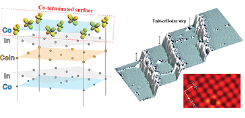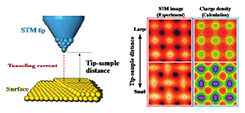Orbital Ordering Visualized by Scanning Tunneling Microscopy
Hasegawa Group
Orbital-related physics attracts growing interest in condensed matter research and there have been reported topics ranging from orbital orders and colossal magnetoresistance to various non-trivial new phenomena, such as superconductivity mediated by orbital fluctuations, orbital Kondo effect, and ordering of multipole moments. However, orbital sensitive probes have so far proved quite limited and there has been no direct access to the real-space form of the orbitals. On the other hand, recent progress of scanning tunneling microscopy (STM) enables the orbital-selective tunneling depending on the tip-sample distance (TSD). Here, we utilize the orbital sensitivity of STM to investigate the surface of the well-known heavy fermion superconductor CeCoIn5 and successfully unveil a surface-assisted cobalt d-orbital order with the support of first principles calculations [1]. Our finding suggests that the surface-assisted orbital ordering could be ubiquitous in transition metal oxides, heavy fermion superconductors, and other materials but has been overlooked.

Fig. 1. (left panel) Schematic of the tetragonal crystal structure of CeCoIn5 with dxz-dyz orbital order at the topmost cobalt plane. (right-top panel) Overview of a typical cleaved surface in this study. Narrow terraces are separated by a step of the unit cell along c axis. The topographic images are colorized with their derivatives to emphasize the atomically resolved lattice structures. (right-bottom panel) Typical atomically resolved STM image taken on the surface.

Fig. 2. STM images of Co-terminated surface with large and small tip-sample distances with corresponding calculated density-of-state mappings based on first principles calculations. The experimental observations are well reproduced with the calculations demonstrating the emergence of dxz-dyz orbital order on the surface.
Our target material CeCoIn5 is naturally born at the quantum critical point having the unconventional d-wave superconducting phase below the critical temperature TC = 2.3 K. The compound has a tetragonal structure composed of three different layers, cerium (Ce)-indium (In), In, and cobalt (Co) layers, stacked in the order of CeIn-In-Co-In-CeIn along the c axis as shown in the left panel of Fig. 1. The second highest critical temperature among heavy fermion superconductors and the availability of high-quality single crystals make this compound the most investigated heavy fermion superconductor.
We cleaved this compound in ultra-high-vacuum condition and measured with low-temperature STM. The right-top panel of Fig. 1 is a typical overview image of the Co-terminated surface of CeCoIn5. Atomically-flat terraces are separated with steps whose height are the unit-cell size along the c axis. In the normal tunneling conditions; when the tip is far away from the surface, spherical-shaped cobalt atoms are visualized on the square lattice as shown in the right-bottom panel of Fig. 1. This atomic shape is coming from states derived from the Co 4s orbital, which has the longer decay into the vacuum than the 3d orbitals. By decreasing TSD extremely to be sensitive to 3d orbitals, we witness drastic changes of the Co atomic shapes as shown in Fig. 2. The Co atomic shape changes from the spherical shape to the elongated dumbbell by decreasing TSD. The elongated directions are the [100] or the [010] directions, which alternate between the adjacent atomic sites. This observation is well reproduced with first principles calculations (the right side of the right panel) and interpreted as the surface-assisted dxz-dyz orbital ordered state.
This surface-assisted orbital order has been overlooked by surface insensitive measurement techniques and even by STM. Since we have experience in STM measurements with very small tip-sample distances [2], which is the first experiment successfully achieving point contact imaging with even smaller tip-sample distances than the present work, we were able to uncover this new phenomenon, achieving the first direct visualization of orbital order in real space. The surface-assisted orbital order is a new concept, but it is not exclusive for heavy fermion compounds. This kind of orbital order should show up in many other compounds containing orbital degrees of freedom in bulk. Therefore, our finding has major relevance not only in heavy fermion physics but also in the broad range of condensed matter physics and material science. Although we have yet to clarify this, there could very well be links between this orbital order and the bulk properties of the compounds. Applying this technique to the other compounds that have been investigated heavily but still poorly understood, such as URu2Si2, we might find a new avenue to explore unsolved mysteries.
References
- [1] H. Kim, Y. Yoshida, C-.C. Lee, T.-R. Chang, H.-T. Jeng, H. Lin, Y. Haga, Z. Fisk, and Y. Hasegawa, Science Advances 3, eaao0362 (2017).
- [2] H. Kim and Y. Hasegawa, Phys. Rev. Lett. 114, 206801 (2015).
